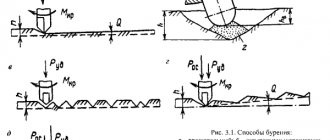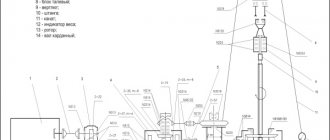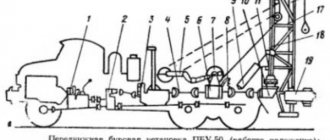PBU 2/2008 “Accounting for construction contracts”
At the end of October 2008, the Ministry of Finance issued a new PBU 2/2008 “Accounting for construction contracts”. It is very different from the previous PBU 2/94 “Accounting for agreements (contracts) for capital construction.” Let's look at what has changed and how to apply it in practice:
- PBU 2/2008 is addressed to contractors and is very close to international standard No. 11 “Construction Contracts”.
- Secondly, the list of contracts covered by this standard is expanding. Contracts for construction-related services have been added to construction contracts.
- Thirdly, this PBU applies only to contracts that are long-term in nature or related to different reporting periods, i.e. The start and end dates of these contracts fall on different reporting years.
- Fourthly, the principles of reflecting contracts in accounting are changing. Let's look at this in more detail. We will also consider how these changes can be applied in 1C programs.
Results
The procedure for reflecting information about various facts and results of economic activities of business entities in accounting is regulated by separate sources of law - PBU. Over time, they will be replaced by new accounting regulations - federal standards.
You can learn more about the specifics of PBU from the articles:
- “Accounting for currency transactions (PBU, postings)”;
- “What are the main differences between PBU and IFRS?”.
You can find more complete information on the topic in ConsultantPlus. Free trial access to the system for 2 days.
Accounting rules according to PBU 2/2008
In accordance with the new PBU, the contractor must keep accounting records of income, expenses and financial results separately for each contract being executed. In this case, additional rules must be observed:
- If one contract provides for the construction of a complex of facilities for one or several customers under a single project, then for accounting purposes the construction of each of them should be considered as a separate contract, subject to the following conditions being simultaneously met:
- if there is technical documentation for the construction of each facility;
- For each object, income and expenses must be reliably determined.
- due to the relationship, individual contracts must actually relate to a single project with a rate of profit determined as a whole for the contracts;
- contracts are executed simultaneously or sequentially (continuously following one another).
New PBUs in 2021–2023
The Ministry of Finance is conducting a global development of federal accounting standards for 2021–2023. According to the order of the Ministry of Finance dated 06/05/2019 No. 83n, new PBUs will be developed and amendments will be made to the already published provisions. The plan for the development and implementation of innovations is shown in the table below.
| No. | PBU project name | Estimated effective date for mandatory application |
| Development of new federal standards | ||
| 1.1 | Reserves | 2021 |
| 1.2 | Intangible assets | 2021 |
| 1.3 | OS | 2021 |
| 1.4 | Unfinished capital investments | 2021 |
| 1.5 | Documents and document flow | 2021 |
| 1.6 | Non-profit activities | 2021 |
| 1.7 | Financial statements | 2021 |
| 1.8 | Income | 2022 |
| 1.9 | Participation in affiliated organizations and joint activities | 2022 |
| 1.10 | Financial instruments | 2022 |
| 1.11 | Debt costs | 2022 |
| 1.12 | Expenses | 2023 |
Additional work in PBU 2/2008
If, during the execution of the contract, additional work is recorded in the technical documentation (an additional construction project is introduced), the implementation of these construction and installation works should be considered as a separate contract. This will have to be done if at least one of the following conditions is met:
- if the additional object differs significantly in structural, technological or functional characteristics from the objects provided for in the contract;
- when the price of additional work is determined on the basis of an estimate agreed by the parties (separate from the main one).
The procedure for determining temporary differences using examples in 1C
Study practical examples of using PBU 18/02 in 1C. Consider a situation in which complex differences arise.
Recognition of SHE and IT
- Acquisition of property with different useful lives in used and auxiliary units. Confession of SHE.
SHE: Difference in asset value
- Provisions for doubtful debts differ in accounting and financial accounting. Confession of SHE.
SHE: Difference in the value of the obligation
- Reserve for repairs of fixed assets at NU. Recognition of IT.
IT: Difference in the value of the obligation
- Depreciation bonus on fixed assets. Recognition of IT.
IT: Difference in asset value
Complex differences
- Purchase of materials if delivery is not taken into account in the NU
Income and expenses in PBU 2/2008
Income under the contract (revenue under the contract) is recognized by the organization as income from ordinary activities in accordance with PBU 9/99 “Income of organizations” (clause 7 of PBU 2/2008). They are determined based on the cost of work at the price determined by the contract. Adjustment of revenue under a contract is possible in three cases - when deviations occur, when claims are made, when incentive payments are received.
To generate expenses in accounting, contracting organizations must be guided by the norms of PBU 10/99 “Costs of organizations” (clause 10 of PBU 2/2008). Expenses under the contract are recognized as expenses for ordinary activities.
Expenses under a construction contract are subject to the general principles of expense recognition (clause 16 of PBU 2/2008):
- expenses are recognized in the reporting period when they were incurred (accrual basis);
- For financial results, expenses are written off as revenue under the contract is recognized (the principle of matching income and expenses).
PBU 2/2008 provides only one way to recognize income and expenses under construction contracts - “as ready” (clause 17 PBU 2/2008). It is based on the fact that a construction contract is a continuous process of production and sales, extended over time. In this case, revenues and expenses under the contract accumulate during the validity of the construction contract. The contractor's profit under the contract can be distributed, if possible, evenly across all reporting periods.
With the “as ready” method, revenue and expenses under the contract are determined based on the degree of completion of work under the contract as of the date of preparation of the financial statements.
Revenue and expenses under the contract should be recognized in the same reporting periods in which the relevant work is performed. In this case, it does not matter whether they should be presented to the customer for payment before the complete completion of the work under the contract (the stage of work provided for by the contract).
Design features
The PBU-2 machine has a base with an automatic diesel engine. This feature perfectly combines the installation with other running frames: ZIL, URAL, KamAZ, MAZ, tracks.
The basic elements are:
- Winch. It allows rope systems to be dropped.
- Rotator. The design allows the tool to be removed from the drilling site in order to carry out other actions or operations. When hydraulics are connected, this element acts on the drill at the very start of work.
- Deck-type power apparatus. It significantly reduces depreciation, fuel consumption, and reduces the cost of operating equipment.
- Hydraulic jacks. They improve balancing and also allow you to securely and accurately fix the machine before drilling.
- Machine control system. It is installed on the running frame at the mast attachment point.
In order to create comfortable operating conditions, the equipment is equipped with a mobile platform for the driver to work.
Basic equipment
The drilling system is equipped with the following devices:
| Tool | Diameter, mm |
| Drill complete with augers | 135, 180, 230, 300, 330, 350, 400 |
| Augers | 200, 250, 320 |
| Chisel-shaped augers | 350 |
| Impact driving device | 98, 108, 127 |
| Gutter device | 98, 108, 168 |
| Auger drills | 650, 850 |
| Driving projectiles | 121 |
| Standard drills | 650, 850 |
| Hammers | 250 |
| Cable-percussion drilling kit | |
| Core element | |
| Set for core drilling (blowing) | |
| Flush core drilling kit | |
| Dry core drilling kit |
Optional system
The list of non-standard equipment includes the following elements for the drilling device:
| Tool | Model |
| Compressor standard | PC - 5.25, 2 VU |
| Screw type compressor | AK-9/10 |
| Pump | NB-50, NB-160/6.3 |
| Heater | 14TS-10 |
| Hammer Drilling Kit: | |
| Elevator | PBU-2.90.00.000 |
| Stuffing box | PBU-2.91.00.000-01 |
| Sealer | PBU-2.93.00.000 |
| Boer | BI7.06.00.000 |
| Fork | BI7.07.00.000 |
| Winch | |
| Balance | |
| Electrical power supply | |
| Conductor |
Revenue accounting in PBU 2/2008
Clause 26 of the PBU determines that revenue under a contract recognized in the “as ready” method is taken into account until the work (stage) is fully completed as a separate asset - “accrued revenue not presented for payment.”
Since PBU does not explain how to take this into account, let us turn to the opinion of auditors. Almost everyone agrees that it is necessary to use account 46 “Completed stages for work in progress.” But there is also an opinion that these works can be accounted for on account 62 or 76. Accounting on account 46 is carried out in the context of contracts/objects. As work progresses, the following entries are made in accounting:
- Dt 46 Kt 90.01 – revenue under the contract is taken into account using the “as ready” method, including VAT;
- Dt 90.02 Kt 20 – cost determined by the “as ready” method;
It is not clear what to do with VAT today. If you read the Tax Code, it says that the object of taxation arises at the moment of transfer of ownership. And since there is no transfer of ownership, there is therefore no tax. It is unknown how the tax inspectorate will look at this. To date, there are no clarifications or comments from the Ministry of Finance.
How to work with a tutorial
BukhExpert8 recommends choosing the option in the accounting policy settings in 1C - Maintained using the balance sheet method .
To master working with PBU 18/02 in 1C, study the materials via the links in chronological order. For convenience, download a memo with visual materials on maintaining PBU 18/02 using the balance sheet method.
The diagrams in the guide will help you navigate the concepts and application of PBU 18/02 in 1C.
A dictionary of abbreviations will help you understand the terms of this standard.
A nice bonus is an example of how to reflect a tax loss in 1C. And also a story about how to calculate tax penalties in the program under PBU 18/02.
All
PBU and 1C
After the release of the PBU, no special changes were made to standard and specialized configurations. One of the developers explained this by saying that everyone is waiting for changes to the chart of accounts and clarifications from the Ministry of Finance.
In standard configurations, such as “1C: Accounting 8” and “1C: Manufacturing Enterprise Management”, accounting “as ready” is not provided. In turn, almost all industry configurations for builders, with the exception of BSP and BSP-Universal, offer their users functionality that allows them to take into account the implementation of stages until the work is completely completed. As a rule, for these purposes, the “Certificate of Work Completed” document provides for the type of operation “phased transfer” or “completion of a stage.” When choosing this type of operation, postings are generated to account 46, with VAT allocated.
Thus, those construction companies that are now ready to use PBU 2/2008 in their practice are forced to either make changes to the standard configuration (usually 1C: Accounting 8) or use industry solutions for builders.
Thus, the software product BIT.CONSTRUCTION/Contractor provides automated accounting in a contractor organization in accordance with PBU 2/2008. The solution allows you to keep separate records of your own and subcontracted construction and installation works, carry out an inventory of work in progress, analyze costs and financial results for construction projects.
Still have questions about the program? Get a free consultation from specialists in your city.
Did you like the article?
Want to receive articles like this every Thursday? Keep abreast of changes in legislation? Subscribe to our newsletter
Reflection of deferred tax in financial financial institutions
Learn how to accurately disclose the indicators of PBU 18/02 in financial statements: after all, the purpose of PBU 18/02 is to show users of financial statements how current transactions with differences between accounting accounting and NU will affect income tax in the future.
- Operations and reports for deferred tax in 1C
- Disclosure of PBU 18/02 indicators in financial statements
- Deferred tax on balance sheet
- Income tax expense in OFR
- Disclosure of deferred tax indicators in the notes to the financial financial statements
Recognition of financial results
We will determine the procedure for recognizing the financial result under the contract at the reporting date. This process includes several stages:
- determination of the type of contract (profitable, unprofitable, it is impossible to determine the financial result);
- determining the degree of completion of work;
- determination of revenue and expenses under the contract;
- determination of the customer's receivables/payables.
PBU 2/2008 is subject to application starting from reporting for 2009, however, for the comparability of financial reporting data, data on construction contracts carried over from 2008 should be adjusted as of 01/01/2009 in such a way as if PBU 2/2008 had been applied before this dates. To adjust data for work contracts started before 01/01/2009, you need to:
- determine what amount of income should be recognized under the contract as of December 31, 2008;
- determine the amount of income adjustment as the difference between the amount of income that was actually recognized under the agreement as of December 31, 2008, and the estimated amount of income;
- calculate the amount of deferred VAT related to the amount of income adjustment;
- determine what amount of expenses should have been recognized under the contract as of December 31, 2008
- calculate the amount of adjustment of expenses as the difference between the amount of expenses that were actually recognized under the contract as of December 31, 2008, and the estimated amount of expenses;
- identify deferred tax assets (DTA) and liabilities (DTA) that existed as of December 31, 2008 and relate to temporary differences in the recognition of income and expenses under construction contracts carried over to 2009;
- identify deviations in terms of income and expenses under the agreement between tax and accounting data as of 01/01/2009 that arose after adjustments in the accounting of income and expenses. Determine the SHE and IT arising in connection with this as of 01/01/2009.
Let's use examples to look at the procedure for reflecting a construction contract in accounting and tax accounting.
Example 3
| Contractor A continues in 2009 to fulfill his obligations under the contract for the construction of the highway, which began in December 2008. In the accounting policy for 2009, the organization established a method for determining the percentage of readiness in proportion to the share of work performed in physical terms in the total volume of work under the contract. To reflect accrued revenue not presented for payment in accounting, the enterprise uses the subaccount of the same name 46-2. The total length of the road under the contract is 5 km, the contractual cost of work is 36,000 thousand rubles. (including VAT - 5,492 thousand rubles). As of the end of December 2008, work on the construction of a 3 km long road had been completed. At the same time, the certificate of completion of work was signed by the customer on December 16, 2008 for the delivery of work on the construction of 2 km of road, which in monetary terms amounted to 14,400 thousand rubles. (including VAT - 2,197 thousand rubles). The costs of completing the scope of work delivered to the customer amounted to 8,000 thousand rubles. Work on the construction of a 1 km long road, completed by the contractor before the end of December 2008, was not accepted by the customer. The actual costs for completing this volume of work amounted to 4,000 thousand rubles. and were reflected in accounting as of December 31, 2008 as costs in work in progress. According to tax accounting data, direct costs in work in progress at the end of the tax period amounted to 2,600 thousand rubles under this agreement. As a result of the difference in the assessment of work in progress for accounting and tax accounting purposes, as of December 31, 2008, the accountant formed an IT in the amount of 336 thousand rubles. ((4,000 - 2,600) thousand rubles x 24%). |
Data correction in accordance with PBU 2/2008 must be made in the following order. The share of contract fulfillment “as ready” as of December 31, 2008 is 0.6 (3 km / 5 km). Accordingly, the income that should be recognized according to the rules of PBU 2/2008 is 21,600 thousand rubles. (36,000 thousand rubles x 0.6), including VAT - 3,295 thousand rubles. (RUB 21,600 thousand / 118 x 18).
The income adjustment will be 7,200 thousand rubles. (21,600 thousand rubles - 14,400 thousand rubles). These incomes must be additionally recognized in the inter-reporting period. The amount of deferred VAT related to the amount of income adjustment is equal to RUB 1,098 thousand. ((7,200 thousand rubles / 118 x 18) or (3,295 thousand rubles - 2,197 thousand rubles)).
The amount of expenses that should be recognized at the end of 2008 in accordance with the requirements of PBU 2/2008 is 12,000 thousand rubles. (8,000 thousand rubles + 4,000 thousand rubles), since this amount relates to the volume of work completed in 2008 on the construction of a 3 km long road. The adjustment of expenses is equal to 4,000 thousand rubles. (12,000 thousand rubles - 8,000 thousand rubles). This value corresponds to the estimate of work in progress under the contract as of December 31, 2008.
The deferred tax liability as of December 31, 2008 related to this agreement amounts to RUB 336 thousand. It must be completely written off in the inter-reporting period. The difference between income recognized in accounting and tax accounting will be 6,102 thousand rubles. (21,600 thousand rubles - 3,295 thousand rubles - 14,400 thousand rubles + 2,197 thousand rubles). It corresponds to an IT in the amount of 1,220 thousand rubles. (RUB 6,102 thousand x 20%).
The difference between expenses in accounting and tax accounting is 2,600 thousand rubles. This will lead to the formation of an IT in the amount of 624 thousand rubles as of 01/01/2009. (RUB 2,600 thousand x 20%).
The adjustment entries will be as follows:
Debit 46-2 Credit 84 - 7,200 thousand rubles. — income adjustment is reflected; Debit 84 Credit 76-onVAT - 1,098 thousand rubles. — deferred VAT accrued; Debit 84 Credit 20 - 4,000 thousand rubles. — adjustment of expenses is reflected; Debit 77 Credit 84 - 336 thousand rubles. - IT is written off; Debit 84 Credit 77 - 1,220 thousand rubles. — IT is reflected according to the difference in income; Debit 09 Credit 84 - 624 thousand rubles. — IT is reflected by the difference in expenses.
Example 4
The contractor began implementing the construction contract in December 2009; completion of the work is planned for February 2010. The total cost of work under the contract is 944 thousand rubles. (including VAT - 144 thousand rubles).
According to the contract, the customer will accept the work in two stages. The first stage is expected to be completed in January 2010, its price is 354 thousand rubles. (including VAT - 54 thousand rubles). The second stage is expected to be completed in February 2010, its cost is 590 thousand rubles. (including VAT - 90 thousand rubles). Payment for completed work is made to customers in full in the month of signing the act of acceptance of the work stage.
The delivery and acceptance of the work was carried out within the time limits established in the contract. We consider the contract profitable. Data on actual and planned costs for the implementation of the contract in each period are presented in Table 1.
Table 1.
| Period | Contract stage | Planned expenses, thousand rubles. | Actual expenses, thousand rubles. |
| December | 1st | 200 | 210, of which 110 are indirect |
| January | 1st | 80 | 75 |
| 2nd | 300 | 320 Balance of direct expenses as of 01/31/2010 - 130 | |
| February | 2nd | 120 | 110 |
| Total | 700 | 715 |
The degree of completion of work as of December 31, 2009 is equal to 0.3 (210 thousand rubles / (210 thousand rubles + 80 thousand rubles + 300 thousand rubles + 120 thousand rubles)). Income under the contract to be recognized for December 2009 is 283 thousand rubles. (944 thousand rubles x 0.3).
The degree of completion of work at the end of January 2010 is equal to 0.83 ((210 thousand rubles + 75 thousand rubles + 320 thousand rubles) / (210 thousand rubles + 75 thousand rubles + 320 thousand rubles . + 120 thousand rubles)). Income under the contract to be recognized for January 2010 amounted to: 500 thousand rubles. (944 thousand rubles x (0.83 - 0.3).
The degree of completion at the end of February 2010 is 1, since the contract has been completed. Income to be recognized for February is 161 thousand rubles. (944 thousand rubles - 283 thousand rubles - 500 thousand rubles).
For more details, see tables 2 and 3.
table 2
| Period | According to calculations in accordance with PBU 2/2008, thousand rubles. | According to certificates of completed work (stages), thousand rubles. | ||||||
| Income | including VAT | Expenses | Profit | Income | including VAT | Expenses | Profit | |
| December | 283 | 43 | 210 | 30 | 0 | 0 | 0 | 0 |
| January | 500 | 76 | 395 | 29 | 354 | 54 | 285 | 15 |
| February | 161 | 25 | 110 | 26 | 590 | 90 | 430 | 70 |
| Total | 944 | 144 | 715 | 85 | 944 | 144 | 715 | 85 |
Table 3
| Period | Accounting, thousand rubles. | Tax accounting, thousand rubles. | Deviations, thousand rubles | |||||||
| Income | including VAT | expenses | financial results | Income | including VAT | expenses | financial results | by income | by expenses | |
| December | 283 | 43 | 210 | 30 | 0 | 0 | 110 | -110 | 240 | 100 |
| January | 500 | 76 | 395 | 29 | 354 | 54 | 365 | -65 | 124 | 30 |
| February | 161 | 25 | 110 | 26 | 590 | 90 | 240 | 260 | -364 | -130 |
| Total | 944 | 144 | 715 | 85 | 944 | 144 | 715 | 85 | 0 | 0 |
The entries shown in Table 4 should be made in the accounting accounts.
Table 4
| Contents of operation | Debit | Credit | Amount, thousand rubles |
| In December 2009 | |||
| Contract costs taken into account | 20.01 | 02, 10, 23, 69, 70, etc. | 210 |
| Accrued revenue not presented for payment is reflected | 46 | 90-1 | 283 |
| Deferred VAT accrued | 90.03 | 76-оVAT | 43 |
| Costs recognized under the contract are written off | 90.02.1 | 20.01 | 210 |
| Deferred tax liability (DTL) has been accrued on income (RUB 240 thousand x 20%) | 68.04.2 | 77 | 48 |
| Deferred tax asset (DTA) has been accrued for expenses (RUB 100 thousand x 20%) | 09 | 68.04.2 | 20 |
| In January 2010 | |||
| Contract costs taken into account | 20.01 | 02, 10, 23, 69, 70, etc. | 395 |
| Accrued revenue not presented for payment is reflected | 46 | 90-1 | 500 |
| Deferred VAT accrued | 90.03 | 76.N | 76 |
| Costs recognized under the contract are written off | 90.02.1 | 20.01 | 395 |
| Tax accrued on income (RUB 124 thousand x 20%) | 68.04.2 | 77 | 25 |
| ONA accrued for expenses (RUB 30 thousand x 20%) | 09 | 68.04.2 | 6 |
| An invoice has been issued to the customer for the first stage of the contract | 62.01 | 46 | 354 |
| VAT accrued for payment to the budget | 76.N | 68.04.2 | 54 |
| Payment received from the customer for the first stage of the contract | 51 | 62.01 | 354 |
| In February 2010 | |||
| Contract costs taken into account | 20.01 | 02, 10, 23, 69, 70, etc. | 110 |
| The remaining portion of the income under the contract is recognized | 46 | 90.01.1 | 161 |
| Deferred VAT accrued | 90.03 | 76.N | 25 |
| Costs recognized under the contract are written off | 90.02.1 | 20.01 | 110 |
| An invoice was issued to the customer for the second stage of the contract | 62.01 | 46 | 590 |
| VAT accrued for payment to the budget | 76.N | 68.02 | 90 |
| IT was written off for income (25 + 48) thousand rubles. or (364 thousand rubles x 20%) | 77 | 68.04.2 | 73 |
| ONA was written off for expenses (20 + 6) thousand rubles. or (RUB 130 thousand x 20%) | 68.04.2 | 09 | 26 |
| Payment received from the customer for the second stage of the contract | 51 | 62.01 | 590 |
Balance method with reflection of PR and BP in 1C
Look at the materials on maintaining PBU 18/02 using the balance sheet method reflecting permanent and temporary differences.
Please note that this setting option, unlike simply the “balance sheet method” , does not have full automation in 1C. It is necessary to analyze all operations and, if necessary, make manual adjustments.
- Selecting an option for maintaining PBU 18/02
- Balance sheet method with reflection of PR and BP
- How to check the maintenance of PBU 18/02 using the balance method with reflection of PR and VR
- How to switch to the balance sheet method reflecting PR and BP?











